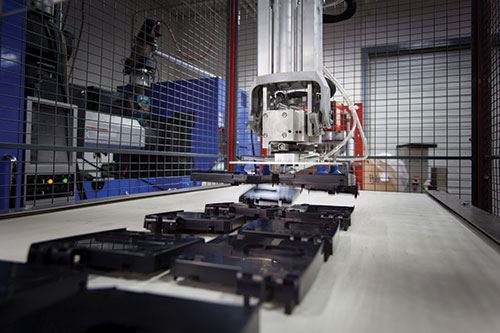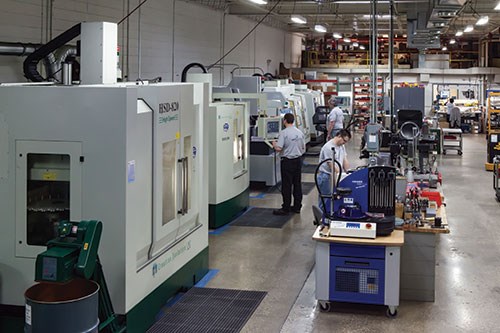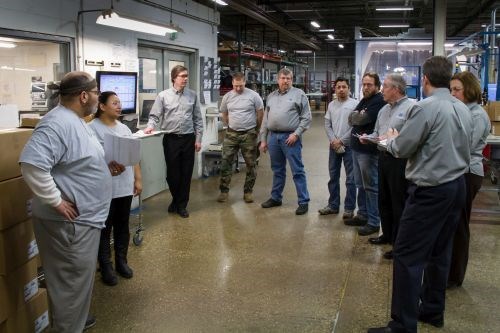Controlling Costs by Controlling Production
A process-driven manufacturing strategy and extensive data tracking have enabled this company to double down on the advantages of integrated toolmaking and molding capability.
There’s been plenty of talk about reshoring during the past few years, and Mike Walter has experienced it firsthand. In fact, the president of MET Plastics says this trend deserves much of the credit for a half decade of steadily increasing sales, not to mention a potential record year in 2014.
Nonetheless, U.S. companies aspiring to global cost competitiveness can’t rely solely on the broad economic forces driving reshoring. In the case of MET Plastics, handling everything but part design under one roof, from tool engineering and manufacturing to molding and final assembly, provides opportunities to identify savings at all stages of the process, Walter says. As an example, he cites a recent job that was awarded primarily because automating assembly kept costs low.
Without the level of control required to design the mold and plastic-injection process specifically for this custom, automated assembly solution, the company may very well have lost the bid.
Yet, attributing this success to the company’s business model is merely scratching the surface. After all, MET Plastics was already set up as an integrated toolmaking and molding operation when Walter joined the Elk Grove Village, Illinois, company in 1995. Things have changed a lot since then, he says, particularly during the past five years. In the 5,000-square-foot moldmaking section of the facility, the company has transitioned from an individualistic production strategy to a team-oriented, process-driven approach that has eliminated past bottlenecks. Meanwhile, heavy investment in automation and a shift from batch processing to single-piece flow have dramatically transformed the adjacent, 18,000-square-foot molding side.
These changes have been critical to minimizing costs on high-end prototype and production runs (100 to 100,000 parts) for the company’s aerospace, industrial equipment, food service and medical industry customers, Walter says. That said, they’re also in-line with industry-wide trends. The difference is that extending the same sort of structured, front-end collaboration practiced by various mold manufacturers to cover molding, too, provides gains that would be unattainable for a more specialized operation. Topping it all off is an extensive focus on tracking a select set of metrics. This keeps the company on track—and always improving—by painting an accurate, objective picture of performance that helps weed out inefficiencies.
Working Together
That’s not to say the two sides of the operation didn’t leverage each other’s input in the past. Today, however, that collaboration is no longer informal. Rather, it’s built into the process. “Ten years ago, we’d have designed the mold, ordered the materials and thrown it over the wall to the toolrooom to build however they wanted,” Walter explains. “Now, a scheduled series of reviews allow everyone to provide input that we can incorporate into the design from the very beginning.”
These reviews start at the quoting stage, when representatives from both sides of the business run through an extensive checklist to identify potential problems. Once awarded the contract, the company conducts a series of launch meetings to develop the entire process, from preliminary design through final assembly, prior to cutting any steel.
The advantages of this approach more than make up for the time this takes at the front end, Walter says. For instance, the team can consider whether gate location, inadequate clearance or other issues might inhibit the sprue pickers and gantry robots installed on its mostly all-electric injection presses from accessing the parts. “Even for lower-volume runs, the focus is on how we can minimize costs by automating production,” Walter says.
He adds that these benefits often extend beyond just production. In one recent example, the company opted to use inserts rather than burn a series of ribs directly into a mold core. For a dedicated moldmaking operation, the latter option would have been a more obvious approach. However, the team at MET Plastics immediately recognized that removable inserts would ease maintenance throughout the tool’s life, because the resin specified by the customer tended to create gas buildup between the deep, difficult-to-access ribs.
Sticking to the Process
With the process finalized, work proceeds precisely according to the plan conceived in pre-production meetings. In the past, a single toolmaker was responsible for planning and executing all tasks involved in a build, from programming toolpaths to operating machines. (These days, the shop’s workhorse equipment consists of two HSD high-speed machining centers from Creative Evolution, as well as a Hurco VMX 42i VMC and a Sodick AG60L sinker EDM, both installed within the past year.) Now, employees still act as jacks of all trades, but the focus is on keeping work flowing. For example, one person might be tasked with keeping the high-speed mills fed while another supervises EDM, with both divvying up benchwork and other tasks while the machines run. The company has achieved an average 14 percent increase in mold-building productivity each year for the past four years, Walter says.
On the other side of the facility, operations proceed with the goal of ensuring employees handle parts as little as possible. The most obvious strategy for this is the extensive use of robots, which are typically programmed to pick parts and present them in the correct orientation for packaging and assembly. The company also minimizes handling by wheeling equipment used for secondary, value-added operations—say, sonic welding—close to the presses as needed. That way, robots can often move parts from press to welder as they eject from the mold to perform all operations in one, continuous process. Compared to a decade ago, when the whole batch would have been molded and then manually transferred to the welders, this single-piece flow strategy has improved efficiency and ensured that any quality issues can be identified immediately, Walter says.
Measuring Success
Streamlining production on both sides of the operation and ensuring they work in concert account for much of the reason why MET Plastics can attain an average on-time delivery rate of 99.5 percent, Walter says. However, avoiding stagnation by continuously learning from past mistakes and identifying new efficiencies is just as critical. To that end, the shop constantly evaluates its performance by tracking key metrics at every step, including spindle utilization, rework, scrap and more. Goals are set and tracked on metrics boards visible throughout the shop, and data is formally evaluated in periodic, scheduled review sessions. Lessons learned are incorporated into the aforementioned project launch checklist to improve future builds.
Initially, much of the shop’s focus on gaining intelligence into its own operations was driven from the outside. Customers and ISO auditors, for example, demand a certain level of traceability. It’s only within the past few years that the shop has leveraged metrics to truly improve. Not all data is useful, Walter says, so it’s important to separate the proverbial wheat from the chaff.
For example, the company used to measure direct and indirect labor hours—that is, how much time employees spent working on a job as opposed to say, sweeping the floor. This might have been useful in a previous era, but it doesn’t mean as much for modern manufacturing operations that rely more on technology. Instead, MET Plastics now tracks value-add per labor dollar, defined as sales less material and outside service costs, divided by total paid employee hours. This metric is not only more useful, but also easier to track through the company’s IQMS ERP software, Walter says.
“We used to measure all kinds of things, and they’d turn out good or bad, but we couldn’t really use the information,” he says. “Now, if we’re going to measure something, we need justification as to why. Proper use of metrics is critical to driving our business and ensuring we are making the changes we need to keep getting better.”
Related Content
Making Quick and Easy Kaizen Work for Your Shop
Within each person is unlimited creative potential to improve shop operations.
Read MoreHow to Improve Your Current Efficiency Rate
An alternative approach to taking on more EDM-intensive work when technology and personnel investment is not an option.
Read MoreEditorial Guidelines: Editorial Advisory Board
The Editorial Advisory Board of MoldMaking Technology is made up of authorities with expertise within their respective business, industry, technology and profession. Their role is to advise on timely issues, trends, advances in the field, offer editorial thought and direction, review and comment on specific articles and generally act as a sounding board and a conscience for the publication.
Read MoreLeading Mold Manufacturers Share Best Practices for Improving Efficiency
Precise Tooling Solutions, X-Cell Tool and Mold, M&M Tool and Mold, Ameritech Die & Mold, and Cavalier Tool & Manufacturing, sit down for a fast-paced Q&A focused on strategies for improving efficiencies across their operations.
Read MoreRead Next
How to Use Continuing Education to Remain Competitive in Moldmaking
Continued training helps moldmakers make tooling decisions and properly use the latest cutting tool to efficiently machine high-quality molds.
Read MoreHow to Use Strategic Planning Tools, Data to Manage the Human Side of Business
Q&A with Marion Wells, MMT EAB member and founder of Human Asset Management.
Read MoreReasons to Use Fiber Lasers for Mold Cleaning
Fiber lasers offer a simplicity, speed, control and portability, minimizing mold cleaning risks.
Read More











.jpg;maxWidth=300;quality=90)




_300x250 1.png;maxWidth=300;quality=90)















